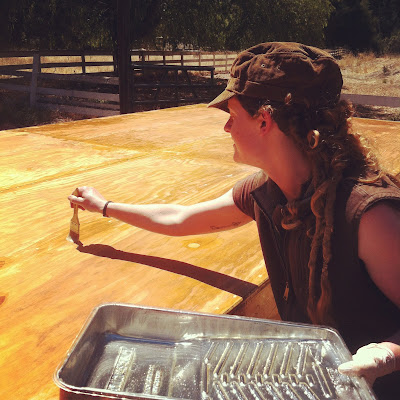Heres where we left the boat last time. Filled, shimmed, routed, sanded lovingly. Lawrence came by a couple times and asked, "What are you building, a boat or a piece of fine furniture?"

Before we started the day, we had to wipe the whole boat down and make sure there was no sawdust, grease, debris, or anything anywhere.

But really, this was just the seal coat, the first of four or five coats wed put on the hull. We wouldnt even get out the glass cloth until the next coat.
And now a quick primer on fiberglass: Fiberglass is a composite laminate material. The layer(s) of spun glass cloth or mat embedded in a matrix of polyester or epoxy resin are what gives it strength.
In some boats where the hull derives its strength from the fiberglass, it is typical to use alternating layers of mat (a loosely woven nest of randomly aligned spun glass) and glass cloth. In our boat, the fiberglass covering on the plywood hull served only the purpose of keeping it watertight and creating a durable wear-resistant maintenance-free surface. So we had only to put one layer of glass cloth between several layers of epoxy.

There are many methods of applying fiberglass to a boat hull, but they break down to the so-called wet and dry methods. "Wet" means the fiberglass cloth (or mat) is laid over a just applied layer of resin and then "wet out" with more resin on top. This sounded hectic. We imagined laying cloth over a wet sticky layer of resin and fighting wrinkles and having the cloth misaligned and pulling our hair out and getting sticky head to foot.
We were relieved to discover in our Glen-L instructions that they recommended the dry method. "Dry" means simply that the first coat is rolled out without the cloth and allowed to set. Then the cloth layer is laid out over this dry layer and more resin on top of that to wet it out. This allows us to carefully align the cloth without the stress of either sticky goo or the ticking clock.

In this first seal coat, all we were doing was covering the hull with epoxy. Kai mixed up big batches of epoxy and put them in paint trays for me to roll out with a dense foam roller.

Then Kai came around with extra resin and touched up spots Id hit too lightly and brushed down any air bubbles. Because we werent mixing the resin with filler, it had a longer pot-life and so didnt tend to kick off early, even though we were mixing it in larger quantities.


The result was beautiful, though vaguely reminiscent of a horribly outdated style of 70s handmade varnished pine bedroom furniture.



Though it was a hot day in the barnyard, we were feeling pretty good about our work and the results.

.jpg)


.jpg)





0 komentar:
Posting Komentar